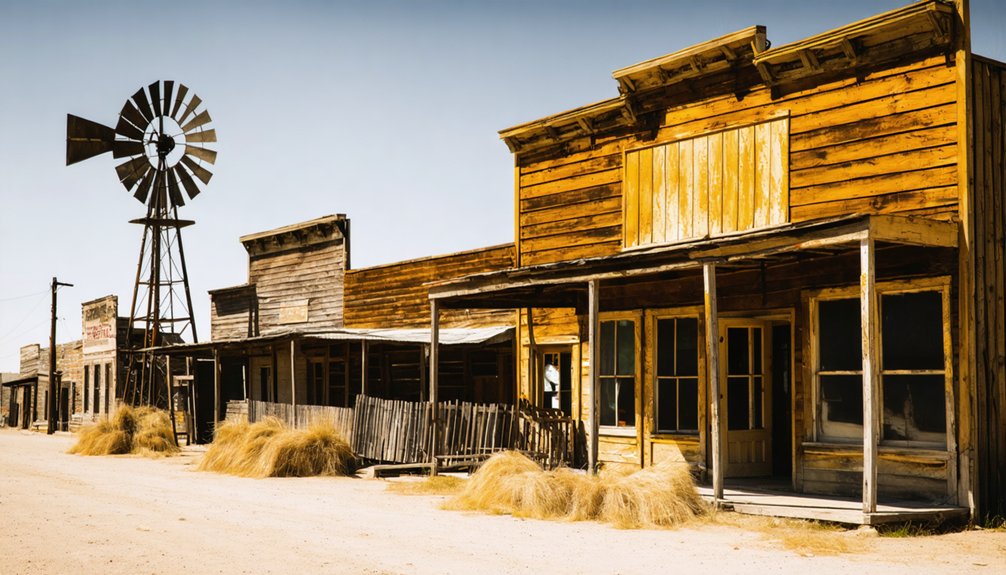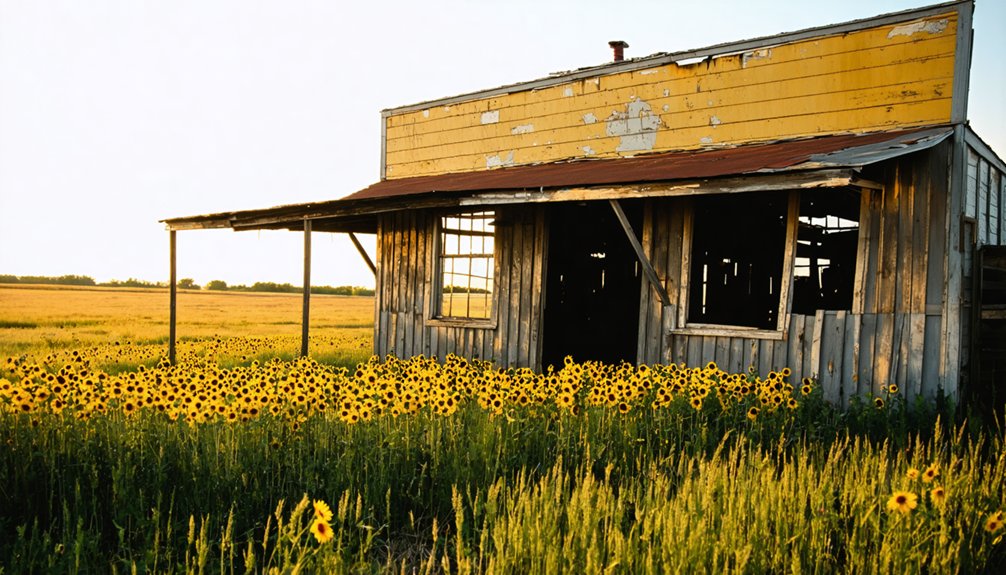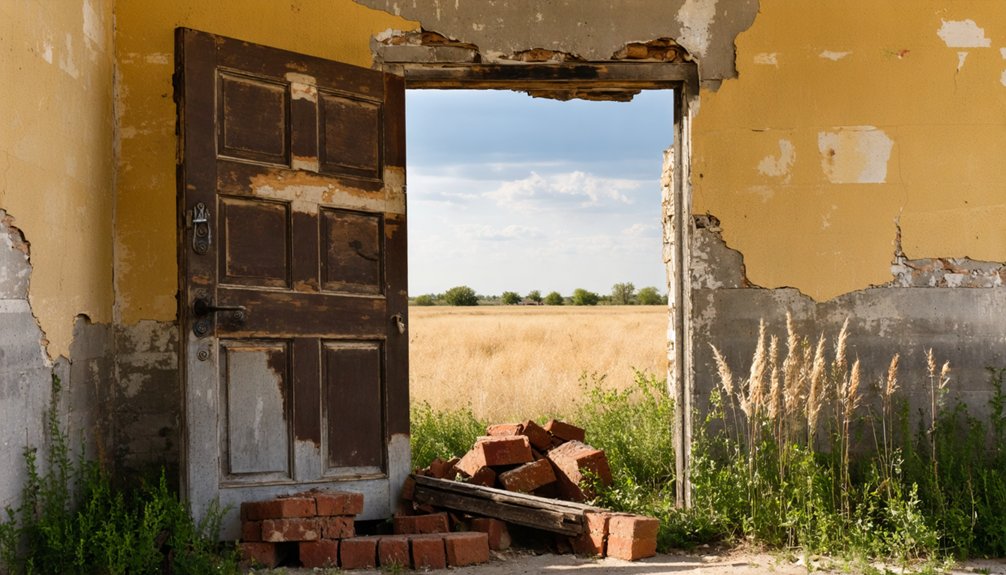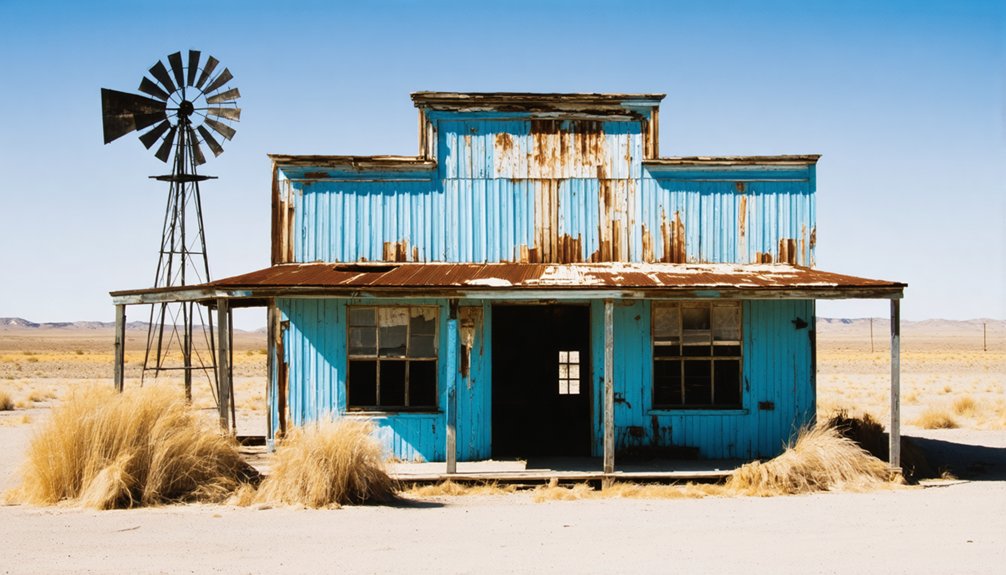You’ll find Ross City’s ghost town ruins in Howard County, Texas, where oil discoveries transformed empty plains into a frontier boomtown in the early 1900s. William Rossman’s planned community grew to 600 residents by 1936, featuring dance halls, general stores, and wooden housing for oil workers. The town flourished during the East Texas oil boom but couldn’t survive when production declined, leading to complete abandonment by the 1950s. The town’s forgotten streets hold countless stories of boom-era Texas.
Key Takeaways
- Ross City emerged as an oil boom town in southeastern Texas during the early 1900s, reaching its peak population of 600 residents by 1936.
- The town was carefully planned by William Rossman with designated zones for residential, commercial, and agricultural development.
- Social life centered around dance halls and community gatherings, with residents living in simple wooden structures built for oil workers.
- The discovery of the Daisy Bradford No. 3 well in 1930 fueled rapid growth, but infrastructure struggled to keep pace.
- Ross City became completely abandoned by the late 1950s due to oil market fluctuations and its remote location.
The Birth of a Frontier Settlement
When oil prospectors first discovered the untapped riches beneath Howard County’s rugged terrain in the early 1900s, Ross City sprang to life as a frontier settlement in southeastern Texas.
You’d have found yourself facing the raw frontier challenges of extreme weather patterns, from biting winter winds to scorching summer heat, as you carved out a life along Farm to Market Road 821.
The settlement dynamics quickly took shape as pioneers built homes, established businesses, and created gathering spaces like the iconic dance hall.
Despite the remote location, you could’ve witnessed the town’s rapid growth as the population swelled to 600 residents by 1936.
Even in the rugged Texas wilderness, Ross City bloomed into a bustling community of 600 souls seeking opportunity.
The Scottish settlers established the first Scottish community in southwest Texas in 1873, laying the groundwork for future development.
The promise of black gold drove the development, though you’d soon learn that betting everything on oil carried significant risks.
The Texas State Historical Association has worked diligently to document and preserve the stories of frontier towns like Ross City for future generations.
William Rossman’s Vision
While many frontier settlements arose haphazardly during Texas’s oil boom, William Rossman approached Ross City’s development with deliberate purpose and careful planning. His community vision centered on creating a self-sustaining hub where families and tradespeople could thrive beyond the typical boom-and-bust cycle of frontier towns.
You’ll find Rossman’s self sufficiency initiatives woven throughout his master plan: carefully mapped zones for residential, commercial, and agricultural development; early investment in roads and water systems; and emphasis on building schools and meeting halls to forge social bonds. Like the careful planning that went into Dublin, California headquarters, Ross City’s development reflected a strategic vision for sustainable growth.
He encouraged farming cooperatives and local markets while promoting cultural activities that would unite diverse settler groups. Unlike other frontier speculators, Rossman wasn’t just seeking quick profits – he aimed to establish an enduring Texas community. One notable entrepreneur in Austin during this era was William Ross, the tailor, who exemplified the type of skilled tradesperson that frontier towns sought to attract.
Oil Boom Years and Economic Growth
You’ll find that Ross City’s transformation during the East Texas oil boom mirrored the explosive growth seen in nearby Kilgore and Longview, as oil workers flooded the region seeking opportunities in the newly discovered fields.
The town’s strategic location near major oil discoveries attracted both skilled roughnecks and ambitious entrepreneurs, who established boarding houses, general stores, and makeshift oil field services to support the burgeoning population. The discovery by Dad Joiner’s well in 1930 sparked unprecedented development in Ross City and surrounding areas. Water became a precious commodity as five cents per cup was charged during the peak of the boom.
Local infrastructure expanded rapidly to accommodate the influx, with hastily constructed roads, water lines, and electrical services struggling to keep pace with the town’s overnight metamorphosis into a bustling oil boom community.
Peak Production and Profits
Following the discovery of the Daisy Bradford No. 3 well in 1930, Ross City’s oil production skyrocketed as part of the unprecedented East Texas Oil Boom.
You’d have witnessed a dramatic transformation as derricks sprouted across the landscape, tapping into America’s largest contiguous oil reservoir. The discovery helped Texas surpass the Russian Empire in global oil production by 1940.
Peak profits came quickly for independent wildcatters who’d bought land cheaply before the boom. Companies like Humble Oil and Refining expanded rapidly, while refineries and pipeline networks grew to handle the massive oil extraction rates. Living conditions were harsh, with workers packed into corrugated iron shantytowns that lacked basic amenities.
But this uncontrolled growth had consequences – you’d have seen oil prices plummet to historic lows due to oversupply.
The situation became so dire that Governor Sterling deployed the National Guard to enforce production limits in 1931, finally bringing stability to Ross City’s chaotic oil market.
Worker Migration Patterns
As the Daisy Bradford No. 3 well erupted in 1930, thousands of workers flooded into Ross City and the surrounding East Texas region, transforming quiet farmland into a bustling industrial landscape.
Worker demographics shifted dramatically as rural farmers abandoned their fields for oil-related jobs, while wildcatters and roughnecks poured in from across the country seeking their fortunes in black gold. The trend reflected Texas’s broader transition from a rural and agricultural state into an increasingly industrial powerhouse. The region experienced another massive population surge when oil prices reached $31.77 per barrel in 1981.
- You’d find tent cities and hastily built shacks housing the surge of workers who couldn’t secure permanent housing.
- Local cafes and boarding houses operated around the clock to serve the constant flow of oil field crews.
- Rural families left their farms in droves, with over 500,000 Texans relocating to oil-producing areas.
- Migration patterns followed the boom-bust cycles, with workers constantly moving to follow the latest strikes.
Infrastructure Development Surge
When the East Texas Oil Field discovery triggered a drilling frenzy in 1930, Ross City’s infrastructure exploded from a quiet rural outpost into an industrial powerhouse.
You’d have seen derricks rising rapidly across the landscape, with pipelines and refineries following close behind.
The town’s unchecked growth mirrored the region’s wider infrastructure challenges, as wells popped up without spacing limits or production controls.
Daily Life in a Texas Boomtown

Life in Ross City revolved around long work shifts at the oil derricks punctuated by crowded social gatherings at makeshift dance halls and gambling houses.
You’d find workers sharing cramped tent housing or hastily constructed wooden shacks, while successful wildcatters and business owners occupied more substantial dwellings on the outskirts of the muddy streets.
Merchants and traders set up temporary storefronts to serve the swelling population, offering everything from basic supplies to entertainment, though most businesses rarely lasted beyond the boom’s peak.
Social Gatherings and Entertainment
Despite the harsh realities of boomtown existence, Ross City’s residents found vibrant ways to create community through social gatherings and entertainment.
The town’s dance hall culture served as the beating heart of social life, where you’d experience live music, dancing, and the forging of lasting bonds amid the oil boom’s uncertainty.
You’d join your neighbors for both formal events and impromptu gatherings, sharing stories and radio tunes under the vast Texas sky.
- Dance at the historic hall that still stands today, a monument to Ross City’s spirited past
- Participate in outdoor festivities celebrating boom milestones and holidays
- Gather with friends for nighttime radio listening and stargazing
- Join card games and informal sports that brought the community together
Work and Trade Patterns
While Ross City’s residents found joy in their social gatherings, the demanding rhythms of boomtown commerce shaped their daily existence.
You’d find yourself caught up in the intense labor demands, whether you were a roughneck working long shifts on the drilling rigs or manning the busy freight yards. The economic hierarchy stretched from wealthy oil executives to transient workers, with everyone scrambling to stake their claim.
Local businesses adapted swiftly to serve your needs, from makeshift supply stores staying open late to hotels housing the steady stream of workers.
You’d dodge trucks and railcars as transportation logistics kept the black gold flowing. The work wasn’t easy – hazardous conditions and physical demands tested your limits – but the promise of oil wealth kept the workforce pushing forward, despite the risks.
Housing and Family Life
In the hastily constructed town of Ross City, you’d find yourself living in simple wooden structures that sprang up almost overnight to house the steady stream of oil workers and their families.
Housing conditions were basic but functional, reflecting the transient nature of boomtown life during the early 1900s.
Family dynamics shifted with the ebb and flow of the oil industry, as households adapted to the challenges of frontier living.
You’d gather with neighbors at the dance hall, forming tight-knit bonds that helped sustain the community through uncertain times.
- Homes lacked modern amenities but fostered resourceful living
- Family activities centered around outdoor recreation and community events
- Neighbors relied heavily on each other for support and entertainment
- Social gatherings at the dance hall strengthened community ties
The Dance Hall Legacy

Through the collective efforts of European immigrants, Texas dance halls emerged as crucial cultural landmarks that shaped the region’s social fabric from the nineteenth century onward.
Texas dance halls stand as living monuments to European immigrant heritage, weaving cultural threads into the state’s diverse social tapestry since the 1800s.
You’ll find that these halls served as more than just dancing venues – they were essential community centers where dance hall traditions flourished, and cultural preservation took center stage.
Located strategically within horse-riding distance of each other, these halls featured sturdy construction with cedar shingle roofs and pine plank floors.
They’d host monthly dances, barbecues, and celebrations like Juneteenth, drawing families from miles around.
Whether you were Czech, German, Polish, or Mexican, you’d discover a welcoming space where your heritage could thrive.
Today, though many halls face closure, organizations like Texas Dance Hall Preservation work tirelessly to protect these irreplaceable pieces of Texas history.
From Prosperity to Abandonment
The story of Ross City‘s dance hall echoes a broader narrative of boom-and-bust that defined this southeastern Howard County settlement.
You’ll find that this once-thriving oil town‘s transformation into a ghost town mirrors the fate of countless Texas boomtowns that couldn’t survive economic shifts.
- Population peaked at 600 residents in 1936 during the height of oil production
- By the late 1950s, the town stood completely abandoned
- Oil market fluctuations devastated the local job market
- Remote location prevented economic diversification
When the oil industry declined, Ross City’s fate was sealed.
The town’s remote location along FM 821 offered little hope for alternative industries.
Without sustained investment or economic opportunities, residents had no choice but to seek employment elsewhere, leaving behind only memories and the weathered dance hall as evidence of more prosperous times.
Exploring Ross City Today

Visitors exploring Ross City today will find little more than scattered remnants of its oil-boom past along FM 821 in southeastern Howard County.
Along FM 821, Ross City stands as a fading echo of Texas oil glory, its remnants scattered across Howard County.
You’ll need to navigate rural roads to reach this remote ghost town, where nature has steadily reclaimed the abandoned townsite.
If you’re planning ghost town exploration here, you’ll want to come prepared.
There’s no infrastructure, cell service, or amenities – just the quiet solitude of West Texas.
You might discover old foundations, weathered structures, and historical artifacts among the vegetation, though most buildings have long since deteriorated.
Remember to bring water, supplies, and a reliable vehicle.
While there aren’t any formal tours or preserved buildings, Ross City offers you an authentic glimpse into Texas’s boom-and-bust heritage.
Preserving a West Texas Heritage
While Ross City’s physical structures have largely vanished, dedicated preservation efforts by local historical organizations and the Texas Historical Commission aim to protect what remains of this West Texas ghost town’s cultural legacy.
You’ll find that cultural preservation initiatives focus on documenting the town’s historical significance through digital archives, oral histories, and educational programs that keep the spirit of Ross City alive for future generations.
- Historical markers now stand where buildings once dominated the landscape, telling the story of Ross City’s boom-and-bust journey.
- Local preservation groups work with the THC to maintain archaeological sites and document remaining artifacts.
- Community-driven efforts guarantee Ross City’s history stays relevant through educational programs and tourism initiatives.
- Digital preservation projects capture stories, photographs, and documents that showcase the town’s role in West Texas development.
Frequently Asked Questions
What Was the Peak Population of Ross City During the Oil Boom?
Like a mirage in the desert, you’d find no definitive peak population records, but based on comparable Texas oil boom towns, Ross City likely peaked at 1,000-3,000 before its population decline.
Are There Any Descendants of William Rossman Still Living in Texas?
You’d need to conduct thorough genealogical research through Texas history records to confirm if any Rossman family descendants still live here, as there’s no definitive public record of their current whereabouts.
What Other Businesses Existed in Ross City Besides the Dance Hall?
You’ll find limited records of businesses beyond the dance hall, though historical patterns suggest Ross City likely had a general store. A saloon’s existence can’t be confirmed through available documentation.
When Was the Last Known Permanent Resident Living in Ross City?
Like tumbleweeds rolling through time, you’d find the last resident’s footprints fading in the late 1950s, when the final holdouts drifted away, leaving only ghost sightings and memories behind.
Did Ross City Ever Have Its Own Post Office or School?
You won’t find records of Ross City having its own post office or school establishment. The nearest post office was in Ross, TX, which opened in 1880 under postmaster Charles E. Kingsbury.
References
- https://www.tshaonline.org/handbook/online/articles/hnr43
- https://texashighways.com/culture/history/the-lost-underwater-towns-of-texas/
- https://en.wikipedia.org/wiki/List_of_ghost_towns_in_Texas
- https://www.ghosttowns.com/states/tx/rosscity.html
- https://en.wikipedia.org/wiki/Ross_City
- https://www.texasescapes.com/TexasGhostTowns/Best-Texas.htm
- https://www.tshaonline.org/handbook/entries/ross-tx
- https://www.texasescapes.com/SouthTexasTowns/Rossville-Texas.htm
- https://www.thestoryoftexas.com/discover/texas-history-timeline
- https://www.hmdb.org/m.asp?m=212152



